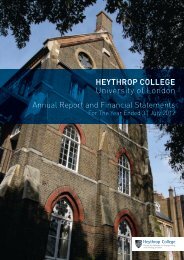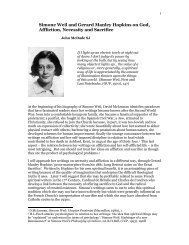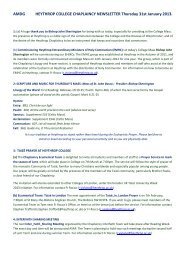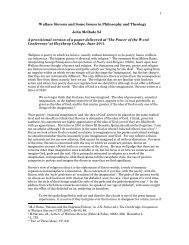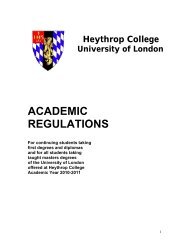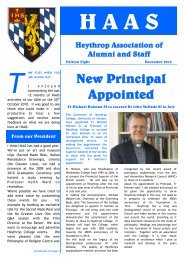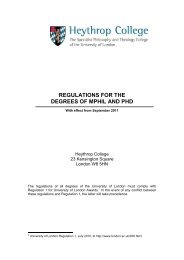Von Balthasar and the Office of Peter in the Church
Von Balthasar and the Office of Peter in the Church
Von Balthasar and the Office of Peter in the Church
You also want an ePaper? Increase the reach of your titles
YUMPU automatically turns print PDFs into web optimized ePapers that Google loves.
6<br />
„As shepherd who has to pasture <strong>the</strong> whole flock, he has a right to claim<br />
authority (<strong>in</strong> doctr<strong>in</strong>e <strong>and</strong> leadership) <strong>and</strong> to dem<strong>and</strong> unity. This<br />
prerogative is his alone. But it does not isolate him from <strong>the</strong> o<strong>the</strong>rs who<br />
have found<strong>in</strong>g missions <strong>and</strong> who, <strong>in</strong> <strong>the</strong>ir own way, have no less a<br />
cont<strong>in</strong>u<strong>in</strong>g life <strong>and</strong> representation <strong>in</strong> <strong>the</strong> church‟ (158)<br />
The <strong>of</strong>fice <strong>of</strong> <strong>Peter</strong>, he argues, „must take his bear<strong>in</strong>gs by <strong>the</strong> all-encompass<strong>in</strong>g<br />
totality <strong>of</strong> <strong>the</strong> <strong>Church</strong>, which expresses itself concretely <strong>in</strong> <strong>the</strong> dynamic<br />
<strong>in</strong>terplay <strong>of</strong> her major missions <strong>and</strong> <strong>in</strong> <strong>the</strong> laws <strong>in</strong>herent <strong>in</strong> her structure‟<br />
(314-5). While he develops this, several alternative configurations are<br />
rejected as <strong>in</strong>adequate: he rejects a neo-scholastic division <strong>of</strong> <strong>the</strong> <strong>Church</strong> <strong>in</strong>to<br />
a „teach<strong>in</strong>g‟ (ecclesia discens) <strong>and</strong> a „listen<strong>in</strong>g‟ part (ecclesia docens),<br />
preferr<strong>in</strong>g a „much more nuanced scale <strong>of</strong> m<strong>in</strong>istries <strong>in</strong> <strong>the</strong> <strong>Church</strong>‟ (236): yet<br />
even <strong>the</strong> New Testament triads <strong>of</strong> „apostles, prophets, teachers‟ (1 Cor 12.28<br />
<strong>and</strong> „evangelists, pastors, teachers‟ (Eph 4.11) are <strong>in</strong>sufficient <strong>in</strong> his view to<br />
account for <strong>the</strong> scale <strong>of</strong> differentiation with<strong>in</strong> <strong>the</strong> Catholica. Nor does he<br />
accept <strong>the</strong> typological division <strong>of</strong> <strong>the</strong> universal <strong>Church</strong> <strong>in</strong>to „Petr<strong>in</strong>e‟<br />
(Catholic), „Paul<strong>in</strong>e‟ (Protestant) <strong>and</strong> „Johann<strong>in</strong>e‟ (Orthodox) <strong>Church</strong>es (146).<br />
Paul <strong>and</strong> John are not to be thought <strong>of</strong> as pr<strong>in</strong>ciples „tend<strong>in</strong>g <strong>in</strong> opposite<br />
directions‟ from <strong>Peter</strong>: communio is not <strong>in</strong>compatible with collegiality <strong>and</strong><br />
primacy. But <strong>the</strong> <strong>of</strong>fice <strong>of</strong> <strong>Peter</strong> is not <strong>the</strong> def<strong>in</strong><strong>in</strong>g feature <strong>of</strong> <strong>the</strong> Catholic<br />
<strong>Church</strong>, as though a Paul<strong>in</strong>e stamp were characteristic <strong>of</strong> Protestantism <strong>and</strong><br />
Johann<strong>in</strong>e contemplation <strong>the</strong> feature <strong>of</strong> Orthodoxy:<br />
...<strong>the</strong> communion <strong>of</strong> <strong>the</strong> Catholica cannot be characterized exclusively by<br />
<strong>the</strong> Petr<strong>in</strong>e pr<strong>in</strong>ciple <strong>and</strong> <strong>the</strong>reby placed <strong>in</strong> opposition to o<strong>the</strong>r Christian<br />
communions <strong>and</strong> communities (145-6)<br />
It is precisely <strong>the</strong> task <strong>of</strong> <strong>the</strong> <strong>Church</strong> to realize its Catholicity <strong>in</strong> ways which<br />
br<strong>in</strong>g toge<strong>the</strong>r <strong>the</strong> Petr<strong>in</strong>e, Paul<strong>in</strong>e, Johann<strong>in</strong>e <strong>and</strong> o<strong>the</strong>r dimensions with<strong>in</strong> a<br />
concrete unity. Petr<strong>in</strong>e authority is at <strong>the</strong> service <strong>of</strong> <strong>the</strong> o<strong>the</strong>r dimensions <strong>of</strong><br />
<strong>the</strong> <strong>Church</strong> <strong>and</strong> it flourishes when it promotes <strong>the</strong> function<strong>in</strong>g <strong>of</strong> <strong>the</strong> o<strong>the</strong>r<br />
missions <strong>and</strong> dimensions with<strong>in</strong> <strong>the</strong> <strong>Church</strong>. When it marg<strong>in</strong>alises itself from<br />
<strong>the</strong>m—for example, by act<strong>in</strong>g as though <strong>the</strong>y had no proper status with<strong>in</strong> <strong>the</strong><br />
life <strong>of</strong> <strong>the</strong> <strong>Church</strong>—or when it is marg<strong>in</strong>alised by <strong>the</strong>m—a not uncommon<br />
attitude <strong>in</strong> some parts <strong>of</strong> <strong>the</strong> Western <strong>Church</strong>—<strong>the</strong> Catholica becomes as<br />
dysfunctional as a family <strong>in</strong> which <strong>the</strong> fa<strong>the</strong>r has no role.<br />
The authority l<strong>in</strong>ked with <strong>the</strong> Petr<strong>in</strong>e <strong>of</strong>fice is one <strong>of</strong> those pr<strong>in</strong>ciples, but it is<br />
not <strong>the</strong> centre <strong>of</strong> <strong>the</strong> <strong>Church</strong>‟s identity: faithful union with Christ, embodied <strong>in</strong><br />
Mary, not <strong>Peter</strong>, is <strong>the</strong> archetypal centre <strong>of</strong> <strong>the</strong> <strong>Church</strong>. He recognises that it<br />
is „difficult to keep <strong>the</strong> <strong>of</strong>fice <strong>of</strong> <strong>Peter</strong> <strong>in</strong> balance with<strong>in</strong> <strong>the</strong> <strong>in</strong>tegral unity <strong>of</strong><br />
<strong>the</strong> <strong>Church</strong>‟ because <strong>the</strong> Petr<strong>in</strong>e <strong>of</strong>fice has frequently drawn energy to itself at<br />
<strong>the</strong> expense <strong>of</strong> o<strong>the</strong>r pr<strong>in</strong>ciples. He aims to restore a better balance to <strong>the</strong><br />
<strong>Church</strong>‟s image <strong>of</strong> itself <strong>and</strong> speaks <strong>of</strong> <strong>the</strong> particularly Catholic concern <strong>of</strong><br />
„balanc<strong>in</strong>g Petrus with Maria-ecclesia‟, <strong>the</strong>reby enabl<strong>in</strong>g <strong>the</strong> Roman aspect to<br />
st<strong>and</strong> <strong>in</strong> a right relationship to <strong>the</strong> more fundamental Marian dimension <strong>and</strong><br />
to <strong>the</strong> o<strong>the</strong>r pr<strong>in</strong>ciples <strong>in</strong> <strong>the</strong> <strong>Church</strong>. The more <strong>the</strong> Petr<strong>in</strong>e <strong>of</strong>fice asserted<br />
itself, from Gregory VII onward he says, <strong>the</strong> more difficult it has been to keep<br />
sight <strong>of</strong> <strong>the</strong> Marian, <strong>and</strong> <strong>the</strong> o<strong>the</strong>r, equally valid, dimensions <strong>and</strong> missions <strong>in</strong><br />
<strong>the</strong> <strong>Church</strong> which counterbalance juridical authority with<strong>in</strong> <strong>the</strong> mysterium<br />
(184). He is aware <strong>of</strong> <strong>the</strong> difficulty <strong>of</strong> <strong>the</strong> task:



